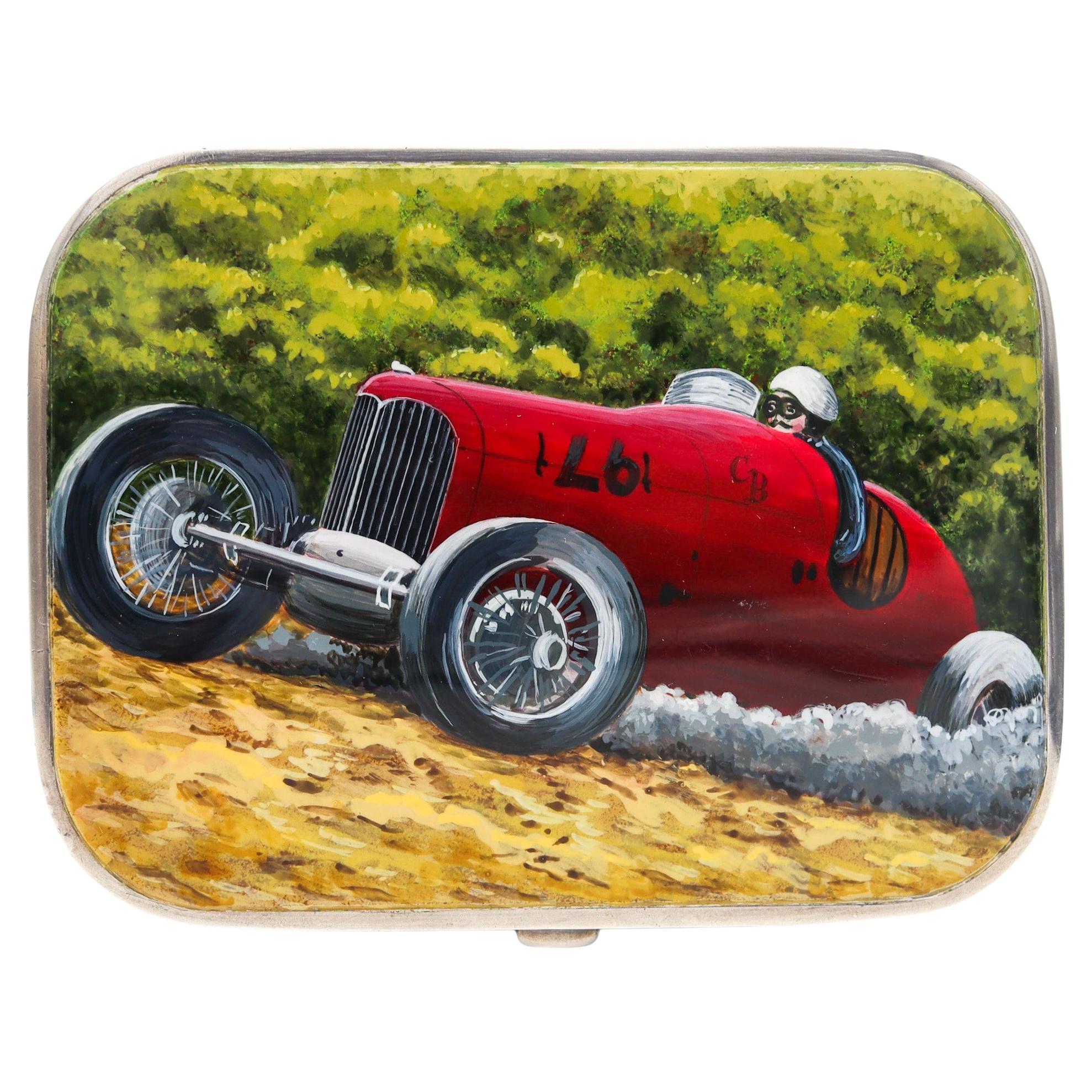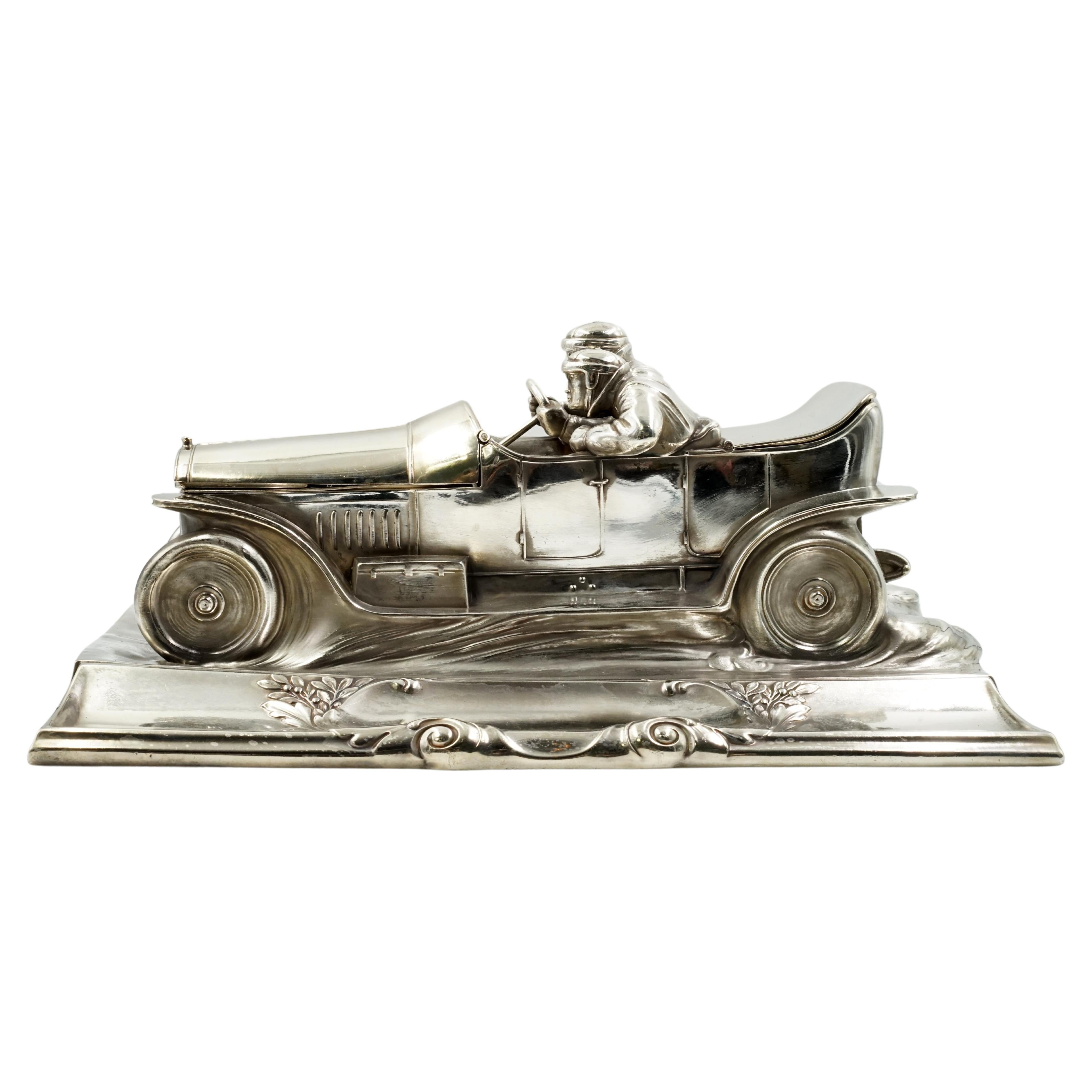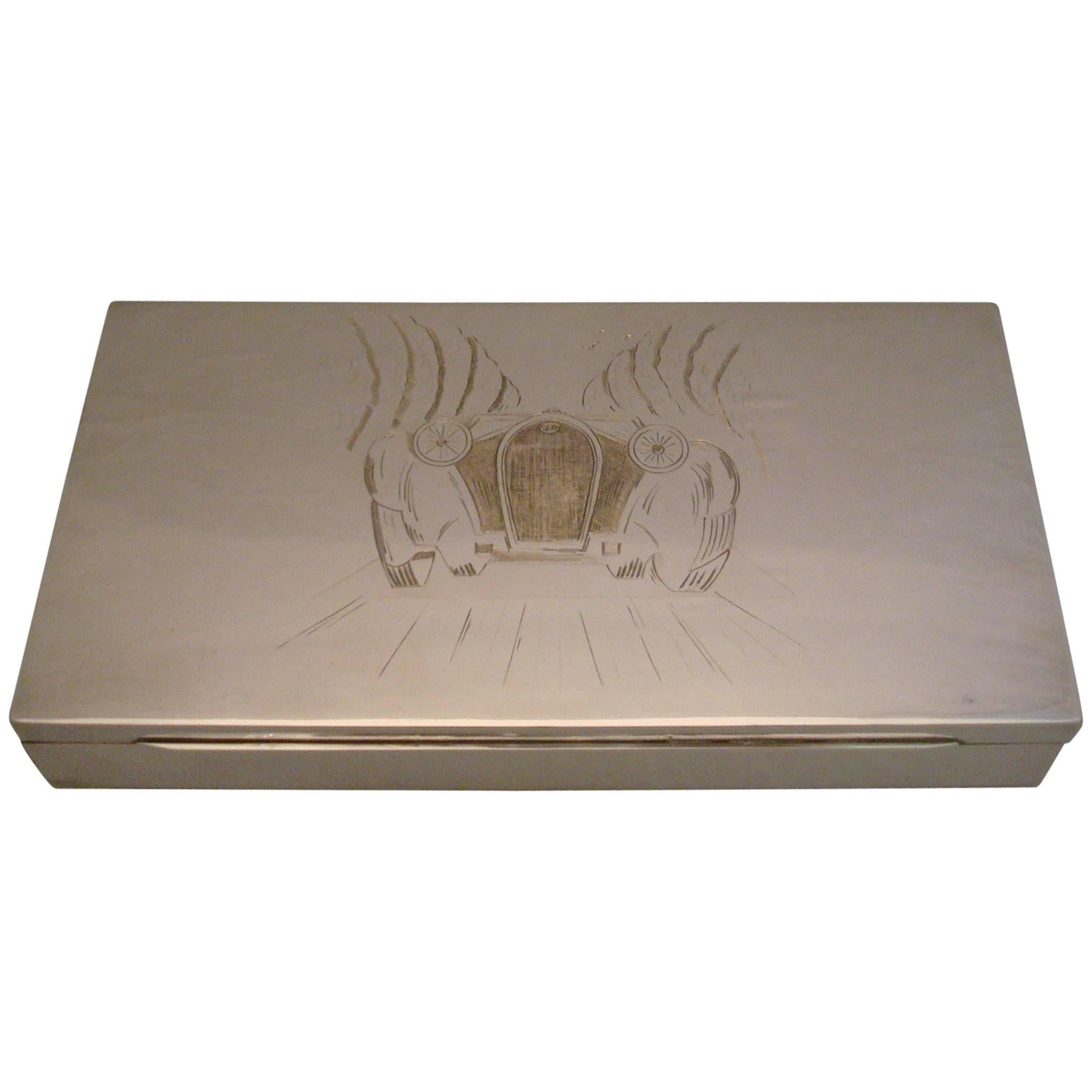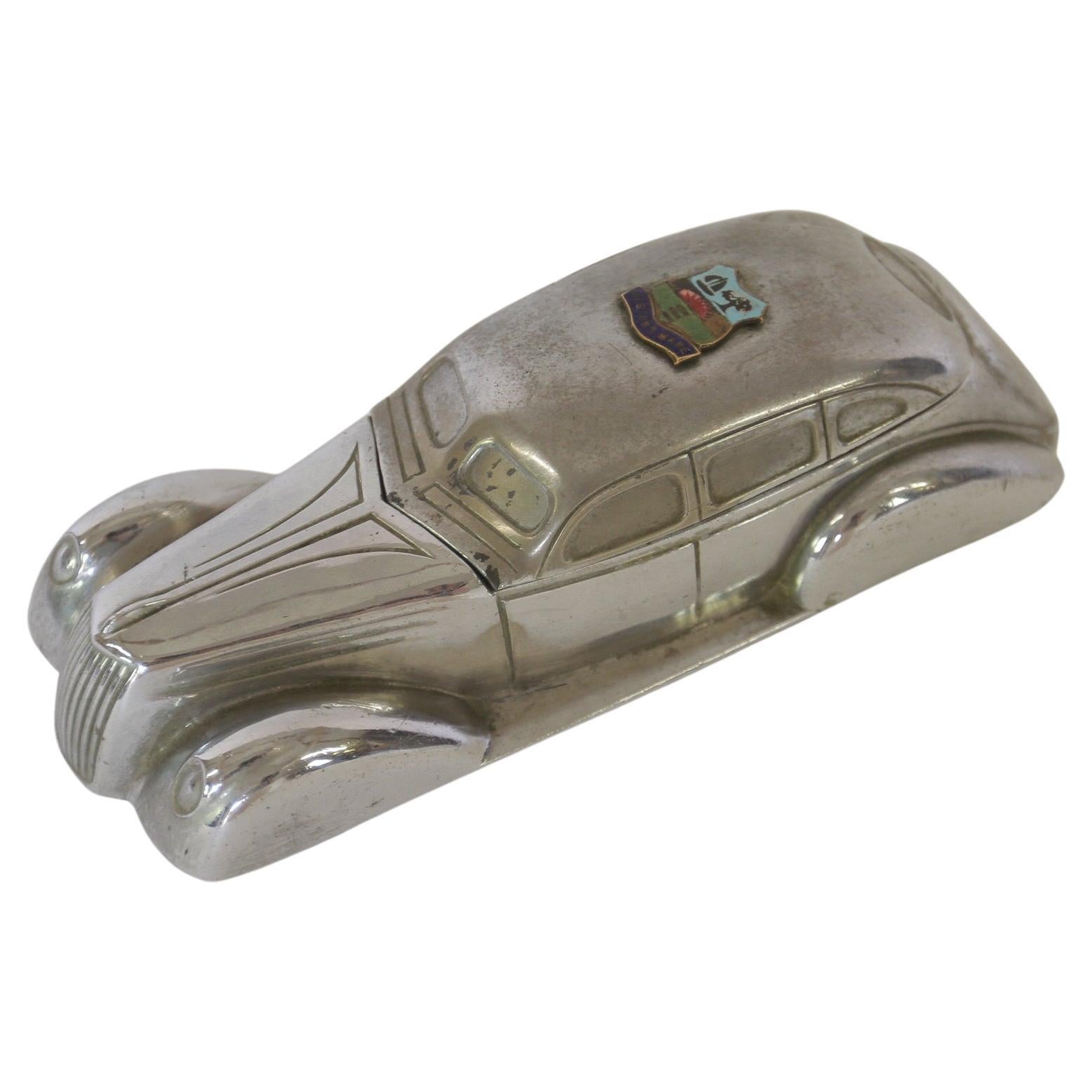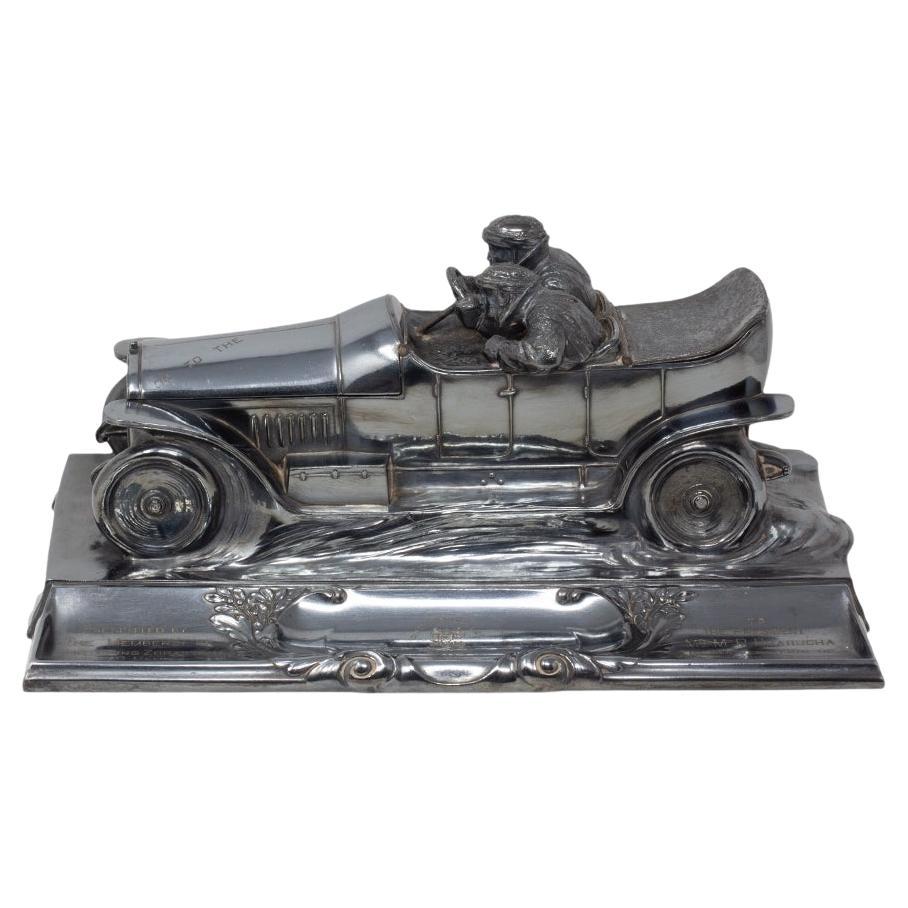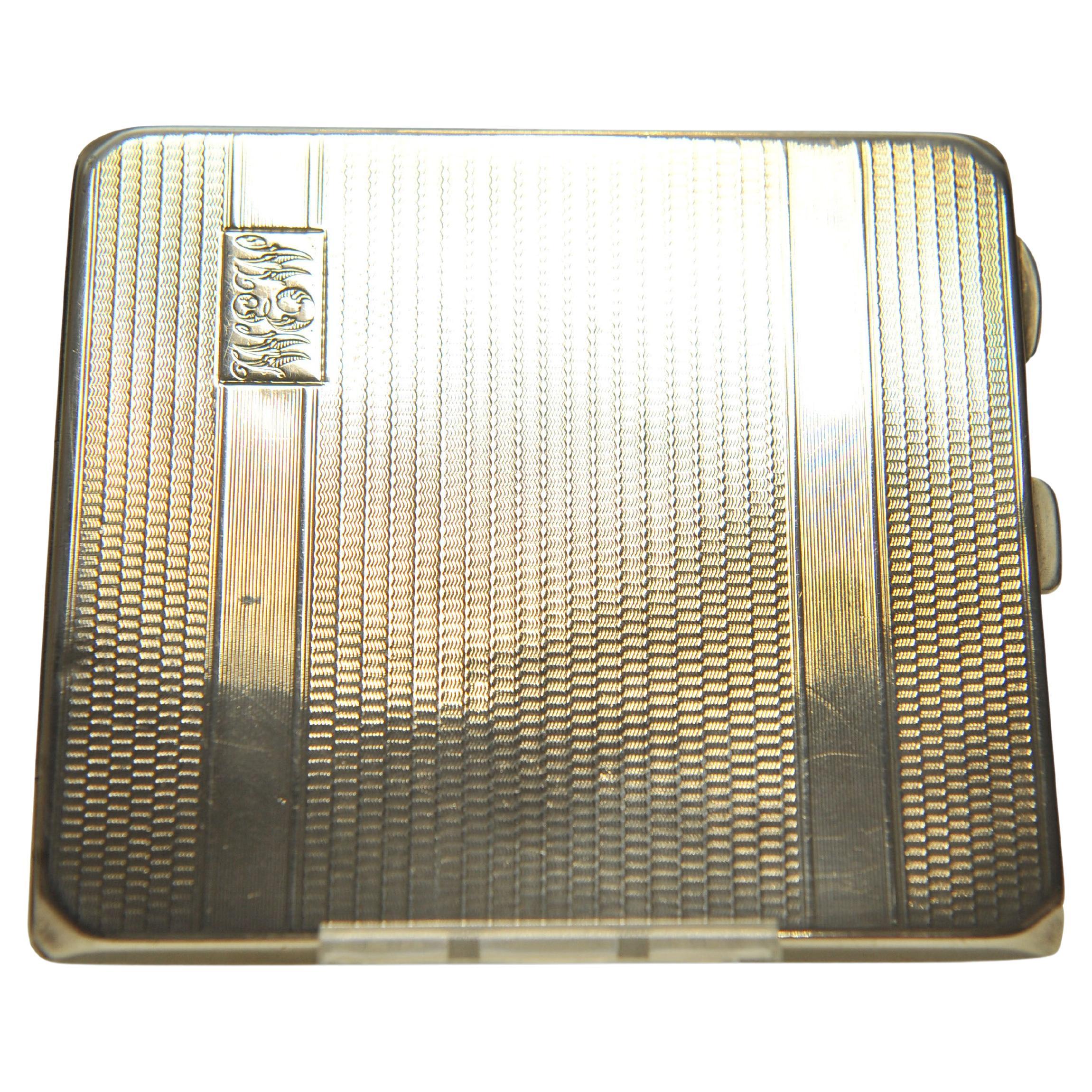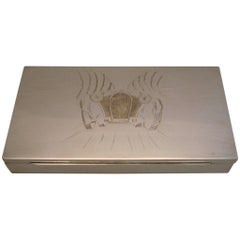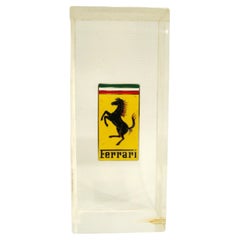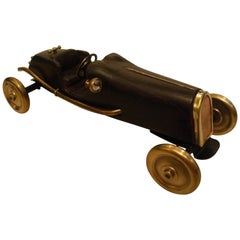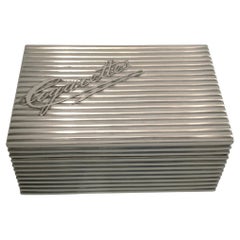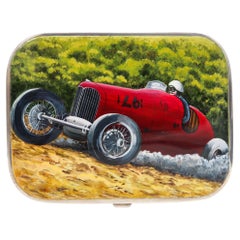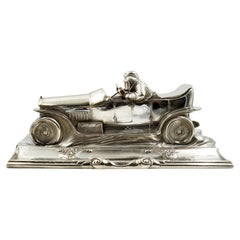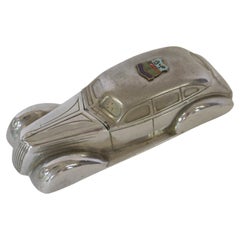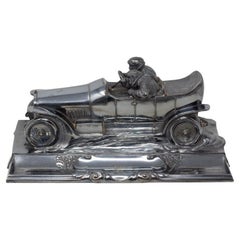Items Similar to Racing Car Sterling Cigarette Case, Mercedes Benz, Automobilia, circa 1918
Want more images or videos?
Request additional images or videos from the seller
1 of 13
Racing Car Sterling Cigarette Case, Mercedes Benz, Automobilia, circa 1918
$1,990
£1,521.46
€1,752.42
CA$2,788.60
A$3,113.21
CHF 1,631.28
MX$38,108.74
NOK 20,717.21
SEK 19,533.70
DKK 13,078.46
About the Item
A magnificent and extremely rare sterling silver engraved cigarette case depicting a stylized Racing car. The car has the emblem of Mercedes Benz.
Marked UK Birmingham Sterling silver, Henry Clifford Davis 1918.
A beautiful and exceptionally rare racing car case, circa 1903, Looks like Camille Jenatzy at the wheel of his 90 horsepower Mercedes race car in the 1903 Coupe Gordon Bennett. Lovely automobile case.
Perfect gift for any car collector, automobilia, car mascot, Hood ornament, can be used as personal cards case.
We have specialized in the sale of Art Deco and Art Nouveau and Vintage styles since 1995. If you have any questions we are at your disposal. Pushing the button that reads 'View All From Seller'. And you can see more objects to the style for sale. Why are there so many antiques in Argentina?
In the 1880 – 1940 there was a grate wave of immigration encouraged by the periods of war that were taking place. 1st World War took place between 1914 and 1918 2nd World War took place between 1939 and 1945 The immigrants options were New York or Buenos Aires. Tickets were cheap and in Buenos Aires they were welcomed with open arms, as it was a country where everything was still to be done. Argentina was the country of new opportunities, labour was needed and religious freedom was assured, in many cases the of the family travel first until they were settled and then the rest of the family members join them. In the immigrant museum “Ellis Island Immigrant Building” in New York you can se the promotional posters of the boats that would take them to a new life. Between the years 1895 and 1896, Argentina had the highest DGP (gross domestic product) per capita in the world according to the Maddison Historical Statistics index, this situation arose due to the large amount of food being exported to European countries, which were at war. The Argentinean ships left the port of Buenos Aires with food, but they returned with furniture, clothes and construction elements, (it´s common to see this the old buildings of the historic neighbourhood of San Telmo, the beams with the inscription “Made in England)”, as well as many markets that were built in Buenos Aires, such us the San Telmo Market, whose structure was brought by ship and afterwards assembled in 900 Defensa Street. With the great influence of European immigrants living in the country, the children of the upper classes travelled to study in France, resulting in the inauguration of “La Maison Argentinienne”, on 27th of June 1928, in the international city of Paris, which hosted many Argentinians that were studying in Frace. It´s the fourth house to be built after France, Canada and Belgium, being the first Spanish-speaking one. Still in place today (17 Bd Jourdan, 75014, Paris, France). Many of the children of these wealthy families who attended international art exhibitions, museums and art courses abroad, took a keen interest in the European style. This is why Buenos Aires was at the time referred as “The Paris of South America”. Between the years 1890 and 1920 more than a hundred Palaces were built on Alvear Avenue the most exclusive avenue in Buenos Aires. Today some of these palaces have been transformed into museums, hotels and embassies. In the year 1936, the Kavanagh building was inaugurated, it was the tallest reinforced concrete building in South America. During 1994 the American Society of Civil Engineers distinguished it as an “international engineering milestone”, and it´s now considered a World Heritage of Modern Architecture. At the time was common to hire foreign architects such as Le Corbusier, who visited Buenos Aires/Argentina in 1929 and in 1948 he drew up the blueprints for a house built in La Plata City (which was declared a World Heritage Site). In 1947, the Hungarian architect Marcelo Breuer designed “Parador Ariston” in the seaside city of Mar del Plata. After an Argentinean student at Harvard University convinced him to come to Argentina. He worked on an urban development project in the Casa Amarilla, area of La Boca. The Ukrainian architect, Vladimiro Acosta, arrives in Argentina in 1928 and worked as an architect until que moved to Brazil. Antonio Bonet, a Spanish architect who worked with Le Corbusier in Paris, arrives in Argentina in 1937, where he carried out several architectural works and in 1938 designs the well-known BFK chair. Andres Kálnay, of Hungarian origin, made around 120 architectural masterpieces, among which the former Munich brewery stands out, he even made the furniture’s design. The German architect, Walter Gropius, director of the Bauhaus, lived in Argentina, where he wrote articles for “Sur” magazine and founded in Buenos Aires, an architectural firm with Franz Möller, who was also an architect, where he built two houses. At the same time several famous designers decided to immigrate to Argentina, among them we can find the well-known French designer, Jean-Michel Frank, who arrived in the country in 1940 and also worked for the Rockefeller family. Special pieces were made, which were sold exclusively in the country, such as the well-known German company “WMF”, who sold their products by catalogue, which were chosen by the ladies of high society in the list of wedding gifts, as well as the pieces designed by Christofle. The Swiss sculptor Alberto Giacometti, made special pieces for Argentinean mansions. In 1904 the first Jansen branch outside Paris was established in Buenos Aires, as the Argentinean clientele demanded a large amount of furniture, from the end of the 19th century to the mid-20th century. In 1970, the brand Rigolleau Argentina made pieces authorised by Lalique. The brands Maple and Thompson also set up shop in the country. The French plastic artist, Marcel Duchamp moved to Argentina in 1918-1919. Glass signed Gallé, Charder, Leverre, Schneider, Muller and other French firms. They were bought in flower shops and were given to ladies with beautiful floral arrangements. Some furniture manufacturers travelled to international fairs and bough the patterns to produce the furniture in Argentina, such as the furniture firm Englander and Bonta, who bought the patterns in Italy. It is worth mentioning that in Argentina we have the largest community of Italians outside of Italy, as it is estimated that 70 percent of the inhabitants have at least one Italian descendant, followed by Spanish immigrants. The most Important furniture stores in Argentina: Comte is founded in 1934 (under the direct management of Jean Michel Frank in 1940). Nordiska (Swedish company established in 1934). Churba in 1960, a company that brought foreign designers to present their furniture in the country: Denmark: (Arne Jacobsen, Finn Juhl, Bender Madsen, Ejner Larsen, Poul Kjaerholm, Hans Wegner) Sweden: (Hans Agne Jakobsson, Gustavsberg) United States: (Herman Miller) Finland: (Lisa Johansson, Folke Arstrom, Tapio Wirkkala, Alvar Aalto, Timo Sarpaneva) Swedish Factory: (Orrefors) Italy: (Littala, Vico Magistretti, Emma Gismondi, Gae Aulenti, Angelo Mangiarotti, Elio Martinelli, Gianna Celada, Angelo Mangiarotti, Mario Bellini, Carlo Scarpa) Finland: (Olivia Toikka) Plata Lappas (Lappas Silver): a goldsmith shop founded in 1887 in Argentina by Alcibiades Lappas of Greek origin. In 2019, in Argentina took place “the Art Deco world congress” . Argentina currently has more than 100 Art Deco buildings and another 90 Art Nouveau buildings throughout the city of Buenos Aires. Argentina is a country that has not been involved in many wars, which is why it has been a refuge for works of art and antiques from different periods of time, unlike European countries. That is way many collectors, museums and antique dealers from all over the world visit it, you should not miss the opportunity to visit this great country.
- Creator:Henry Clifford Davis (Jeweler)
- Dimensions:Height: 3.15 in (8 cm)Width: 3.75 in (9.5 cm)Depth: 0.63 in (1.6 cm)
- Style:Art Deco (Of the Period)
- Materials and Techniques:
- Place of Origin:
- Period:
- Date of Manufacture:1918
- Condition:Wear consistent with age and use.
- Seller Location:Buenos Aires, AR
- Reference Number:1stDibs: LU2027316006021
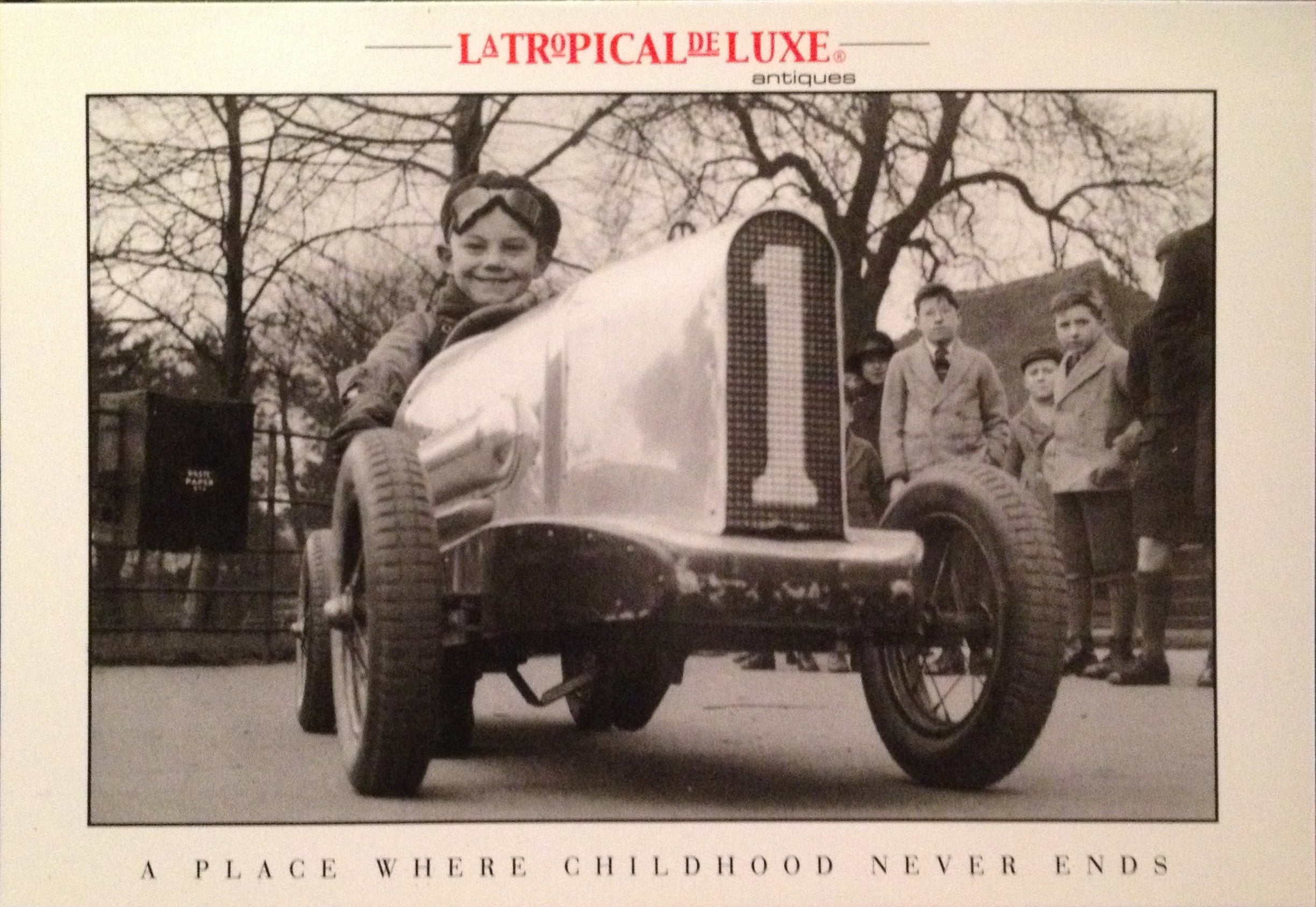
About the Seller
4.9
Vetted Professional Seller
Every seller passes strict standards for authenticity and reliability
Established in 2002
1stDibs seller since 2016
320 sales on 1stDibs
Typical response time: 1 hour
- ShippingRetrieving quote...Shipping from: Buenos Aires, Argentina
- Return Policy
Authenticity Guarantee
In the unlikely event there’s an issue with an item’s authenticity, contact us within 1 year for a full refund. DetailsMoney-Back Guarantee
If your item is not as described, is damaged in transit, or does not arrive, contact us within 7 days for a full refund. Details24-Hour Cancellation
You have a 24-hour grace period in which to reconsider your purchase, with no questions asked.Vetted Professional Sellers
Our world-class sellers must adhere to strict standards for service and quality, maintaining the integrity of our listings.Price-Match Guarantee
If you find that a seller listed the same item for a lower price elsewhere, we’ll match it.Trusted Global Delivery
Our best-in-class carrier network provides specialized shipping options worldwide, including custom delivery.More From This Seller
View AllCar Bugatti Royale engraved Cigar - Cigarette Case - Automobilia
Located in Buenos Aires, Olivos
Fantastic engraved Cigar - Cigarette case with a Bugatti Royale. Bugatti type 41. Very nice piece of automobilia. Perfect gift for a Classic car or car mascot - hood ornament collector.
Category
Vintage 1930s French Art Deco Tobacco Accessories
$2,299 Sale Price
23% Off
Vintage Ferrari Cars Badge / Emblem Lucite Desk Paperweight. Italy 1970´s
Located in Buenos Aires, Olivos
Vintage Ferrari Badge / Emblem Lucite Desk Paperweight. Italy 1970´s.
Very nice Ferrari Advertising paperweight.
We have specialized in the sale of Art Deco and Art Nouveau and Vin...
Category
Late 20th Century Italian Mid-Century Modern Paperweights
Materials
Lucite
Folk Art Early Racing Speedway, Indianapolis Type, Brass and Wood, Automobilia
Located in Buenos Aires, Olivos
Fantastic vintage racing car, the Indianapolis type. Very nice done. Handmade. Perfect for any Automobilia, or Car Mascot - Hood Ornament collector. Very good conditions. Just got a ...
Category
Early 20th Century American Art Deco Models and Miniatures
Materials
Brass
Asprey Art Deco Cigarettes Box. 1930´s
By Asprey International Limited
Located in Buenos Aires, Olivos
Metal case with a grooved texture. On the top of the box is written the word "Cigarettes" in cursive script. The box was designed to store cigarettes. The ribbed texture and metallic...
Category
Mid-20th Century British Mid-Century Modern Tobacco Accessories
Materials
Metal
Bugatti Tank Car Mascot / Hood Ornament / Paperweight. France 1930
Located in Buenos Aires, Olivos
Bugatti Tank Car Mascot / Hood Ornament / Paperweight. France 1930.
Silvered Bronze Sculpture depicting a Bugatti Type 32 ¨Tank¨ Car.
Mounted over an acylic base. Signed CAD.
Lovely ...
Category
Mid-20th Century French Art Deco Paperweights
Materials
Bronze
Desk Equestrian Horse Racing Cigar Smoking Box, circa 1900s
Located in Buenos Aires, Olivos
Equestrian cigar box with space for matches. Perfect desk piece.
Engraved with racing horses.
We have specialized in the sale of Art Deco and Art Nouveau and Vintage styles since 19...
Category
Early 20th Century American Art Nouveau Tobacco Accessories
Materials
Brass
You May Also Like
Finnigans 1932 London Art Deco Enamel Case Box With Racing Car In .925 Sterling
By Finnigans, London 1, Finnigans, London 1
Located in Miami, FL
Art deco Enamel case designed by Finnigans Limited.
This extraordinary and beautiful cased-box, was created in London England during the Art Deco period. Has a great provenance and was designed by the famous silversmiths and retail store of Finnigans Limited, back in the 1932. The thematic of this box is rare and very popular. Has been crafted in solid .925/.999 sterling silver standard with gilded interiors. The case has been made in a cushioned compact shape with eight barrels hinge and a push pressure thumb. The main panel on top is illustrated with a landscape scene and a Formula-1 racing red car, with the number L6, all realized with polychrome enamels. The reverse is embellished with engine turned guilloche decorations. This fine piece is masterfully worked with extreme details and is a very especial example for any collector, or a wonderful gift for someone special. It is in perfect preserved condition.
Weight: 135.98 Grams, (87.16 Dwt).
Measurements: 85 mm by 111.3 mm by 8 mm (3.35 x 4.38 x 0.11 Inches).
Hallmarks: Both parts are Stamped with British marks; the mark of the lion for the city of London, the maker's mark Fs.Ld associated to Finnigans Limited, the Gothic letter R for the production year 1932, and signed, "FINNIGANS LTD. LONDON".
Finnigans Limited
The House of Finnigans was founded by Brian Finnigan in 1830. Brian Finnigan established the house as a sole proprietor and opened a workshop in Newton...
Category
Vintage 1930s English Art Deco Decorative Boxes
Materials
Silver, Sterling Silver, Enamel
$3,400 Sale Price
20% Off
W.M.F inkwell art nouveau racing car
By WMF Württembergische Metallwarenfabrik
Located in Buenos Aires, Argentina
W.M.F inkwell art nouveau racing car
Origin Germany Circa 1915
Excellent condition. It has all its original parts
Electroplated metal
Sealed on the back
The car is a Mercedes Benz of...
Category
Vintage 1910s German Art Nouveau Inkwells
Materials
Metal
Art Deco Chrome Streamlined Car Trinket Box 1930s
By Alfred Dunhill
Located in Dereham, GB
Art Deco Chrome Streamlined Car Trinket Box 1930s
Brass casting
Good Art deco Streamlined shaped car
Chrome Plated
Hinged top trinket box/desk tidy
Enamel badge on top Reads WESTON.S...
Category
Vintage 1930s French Art Deco Decorative Boxes
Materials
Chrome
German Art Deco Rally Car Desk Compendium by WMF
By WMF Württembergische Metallwarenfabrik
Located in Newark, England
From our Collectables category, we are thrilled to offer to the market this rare example Art Deco Rally Car Desk Compendium by WMF (Württembergische Metallwar...
Category
Early 20th Century German Art Deco Desk Sets
Materials
Silver Plate
British Sterling Silver Art Deco Engraved Cigarette Case By Harman Bros. 1931
By Harman Brothers
Located in Reading, Berkshire
Elegant Art Deco Sterling Silver Engraved Cigarette Case By Renowned British SilverSmiths Harman Bros. Birmingham 1931. Weight 129grams
Hallma...
Category
Early 20th Century British Art Deco Snuff Boxes and Tobacco Boxes
Materials
Silver
1910s Sterling Silver Blankinton Match Safe • Automobile Chauffeur Driver
By Blankinton & Co.
Located in Lancaster, PA
A striking and highly detailed sterling silver match safe, this c. 1910s example attributed to Blackinton features a bold raised depiction of a whimsical chauffeur gripping a steerin...
Category
Vintage 1910s American Art Nouveau Tobacco Accessories
Materials
Silver
More Ways To Browse
Cigarette Set
Museum Of Modern Art Collectible Chairs
Art Deco Racing
Antique Cigarette Cases
Sterling Silver Cigarette Case
Children Cars
Deco Cigarette Case
Antique Silver Cigarette Case
Cigarette Cards
Art Deco Silver Cigarette Case
Cigarette Cases
Antique Curiosities Uk
Italian Cigarette Case
French Cigarette Case
Gordon Antique Furniture
Vintage And Collector Cars
Vintage Childrens Car
Wheel Chair Used
